World Roundup
July/August 2019
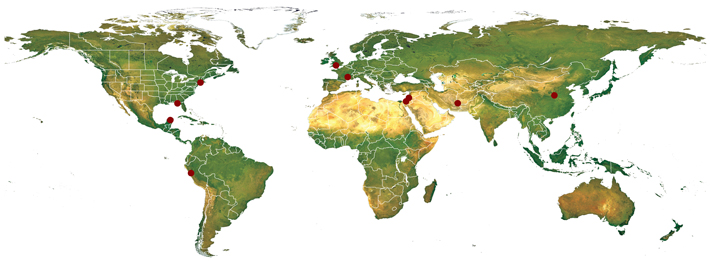

-
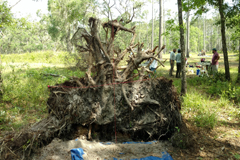 FLORIDA: Artifacts from a 19th-century African-American community were exposed when Hurricane Michael uprooted dozens of trees at the site of a fort located on the Apalachicola River. The fort was originally built by the British during the War of 1812, and became a place of refuge for thousands of freed and escaped slaves who joined the British side. Shortly after the war’s end, the U.S. Navy attacked the fort, blowing up a munitions cache inside and killing hundreds of people.
FLORIDA: Artifacts from a 19th-century African-American community were exposed when Hurricane Michael uprooted dozens of trees at the site of a fort located on the Apalachicola River. The fort was originally built by the British during the War of 1812, and became a place of refuge for thousands of freed and escaped slaves who joined the British side. Shortly after the war’s end, the U.S. Navy attacked the fort, blowing up a munitions cache inside and killing hundreds of people. -
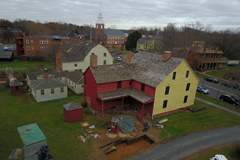 CONNECTICUT: Coins, wampum beads, and other colonial-era objects found near the Webb-Deane-Stevens Museum in Wethersfield may be associated with the earliest settlers of Connecticut’s oldest English town. Archaeologists hope that these objects, along with the remains of a 17th-century wooden palisade, will provide vital information on one of the most infamous events in the state’s history—a 1637 raid by Pequot Indians that killed several colonists and helped fuel the deadly conflict known as the Pequot War.
CONNECTICUT: Coins, wampum beads, and other colonial-era objects found near the Webb-Deane-Stevens Museum in Wethersfield may be associated with the earliest settlers of Connecticut’s oldest English town. Archaeologists hope that these objects, along with the remains of a 17th-century wooden palisade, will provide vital information on one of the most infamous events in the state’s history—a 1637 raid by Pequot Indians that killed several colonists and helped fuel the deadly conflict known as the Pequot War. -
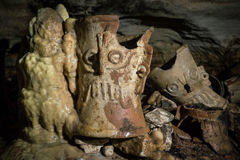 MEXICO: After a villager notified authorities about a cave hidden beneath the Maya site of Chichen Itza, archaeologists crawled hundreds of feet through passages that were only 16 inches high in places. In the cave, they encountered hundreds of undisturbed ritual artifacts, including incense burners depicting the rain god Tlaloc. The region experienced a severe drought toward the end of the first millennium A.D., which may have compelled the Maya to descend into the cave and entreat the gods for rain.
MEXICO: After a villager notified authorities about a cave hidden beneath the Maya site of Chichen Itza, archaeologists crawled hundreds of feet through passages that were only 16 inches high in places. In the cave, they encountered hundreds of undisturbed ritual artifacts, including incense burners depicting the rain god Tlaloc. The region experienced a severe drought toward the end of the first millennium A.D., which may have compelled the Maya to descend into the cave and entreat the gods for rain. -
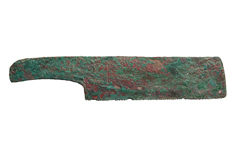 PERU: An archaeology student walking through the site of Castillo de Huarmey fell into a hole, accidentally discovering the tomb of a Wari metallurgist dating to around A.D. 800. The craftsman, who was approximately 20 years old when he died, was buried in a sitting position with his hands placed around a fabric bundle containing what appears to be an assortment of his favorite tools of the trade. The collection includes bronze knives, an ax, a saw, and bone-handled chisels.
PERU: An archaeology student walking through the site of Castillo de Huarmey fell into a hole, accidentally discovering the tomb of a Wari metallurgist dating to around A.D. 800. The craftsman, who was approximately 20 years old when he died, was buried in a sitting position with his hands placed around a fabric bundle containing what appears to be an assortment of his favorite tools of the trade. The collection includes bronze knives, an ax, a saw, and bone-handled chisels. -
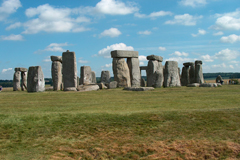 ENGLAND: During the 3rd millennium B.C., Neolithic Britons held annual celebrations at sacred monuments such as Stonehenge. New research reveals that people from all over the island attended these BYOP—Bring Your Own Pig—feasts. Isotope analysis of porcine bones from several henge sites in southwestern England indicates that the pigs eaten there were not raised locally. Not only did festivalgoers travel from as far away as Scotland, northeastern England, and western Wales, they transported their own pigs with them.
ENGLAND: During the 3rd millennium B.C., Neolithic Britons held annual celebrations at sacred monuments such as Stonehenge. New research reveals that people from all over the island attended these BYOP—Bring Your Own Pig—feasts. Isotope analysis of porcine bones from several henge sites in southwestern England indicates that the pigs eaten there were not raised locally. Not only did festivalgoers travel from as far away as Scotland, northeastern England, and western Wales, they transported their own pigs with them. -
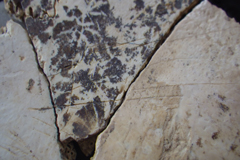 FRANCE: Around 120,000 years ago, for a group of Neanderthals living in southeastern France, drastic times called for drastic measures. During a period of rapid warming, food became scarce, and, on at least one occasion, they were forced to eat their own. New insight into the Moula-Guercy Cave, where the dismembered and butchered remains of 6 individuals were found, suggests that, in the sudden absence of large mammals such as mammoth and reindeer, the meat-reliant Neanderthals were driven to cannibalism.
FRANCE: Around 120,000 years ago, for a group of Neanderthals living in southeastern France, drastic times called for drastic measures. During a period of rapid warming, food became scarce, and, on at least one occasion, they were forced to eat their own. New insight into the Moula-Guercy Cave, where the dismembered and butchered remains of 6 individuals were found, suggests that, in the sudden absence of large mammals such as mammoth and reindeer, the meat-reliant Neanderthals were driven to cannibalism. -
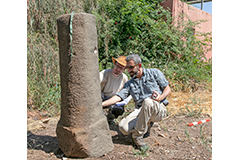 ISRAEL: A difficult-to-read inscription on a Roman mile marker in the Golan Heights has finally been deciphered. The inscription was found to bear the name and titles of the Roman emperor Maximinus Thrax, who ruled from A.D. 235 to 238. Among several distance markers that have been located along the Roman road outside ancient Hippos, this is the only one with any writing. Since the road was built long before the 3rd century A.D., it must have undergone substantial renovations during the emperor’s reign.
ISRAEL: A difficult-to-read inscription on a Roman mile marker in the Golan Heights has finally been deciphered. The inscription was found to bear the name and titles of the Roman emperor Maximinus Thrax, who ruled from A.D. 235 to 238. Among several distance markers that have been located along the Roman road outside ancient Hippos, this is the only one with any writing. Since the road was built long before the 3rd century A.D., it must have undergone substantial renovations during the emperor’s reign. -
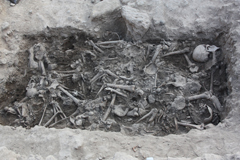 LEBANON: Between the 11th and 13th centuries, hundreds of thousands of Europeans ventured to the Near East in a campaign to reconquer the Holy Land. A new study suggests that the Crusader army may have been more diverse than originally thought. DNA sequencing of 9 soldiers who were buried together in a mass grave near Sidon in the 13th century revealed, to the researchers’ surprise, that 3 were European, 4 were Near Eastern, and 2 had a mixture of European and Near Eastern ancestry.
LEBANON: Between the 11th and 13th centuries, hundreds of thousands of Europeans ventured to the Near East in a campaign to reconquer the Holy Land. A new study suggests that the Crusader army may have been more diverse than originally thought. DNA sequencing of 9 soldiers who were buried together in a mass grave near Sidon in the 13th century revealed, to the researchers’ surprise, that 3 were European, 4 were Near Eastern, and 2 had a mixture of European and Near Eastern ancestry. -
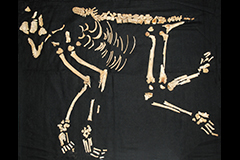 IRAN: The necropolis in Shahr-i-Sokhta (“Burnt City”) in southeastern Iran contains burials of as many as 37,000 humans—and at least one rhesus macaque. The animal was likely kept as the pet of a wealthy family. When it died more than 4,500 years ago, it was interred in the cemetery in the same style as a human infant. The monkey species, which was seen as a symbol of wealth, power, and prestige, is not native to Iran and may have been imported from the Indus Valley.
IRAN: The necropolis in Shahr-i-Sokhta (“Burnt City”) in southeastern Iran contains burials of as many as 37,000 humans—and at least one rhesus macaque. The animal was likely kept as the pet of a wealthy family. When it died more than 4,500 years ago, it was interred in the cemetery in the same style as a human infant. The monkey species, which was seen as a symbol of wealth, power, and prestige, is not native to Iran and may have been imported from the Indus Valley. -
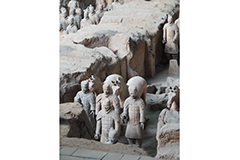 CHINA: One of the most remarkable aspects of the Terracotta Army is the pristine state of the soldiers’ bronze weapons after 2,000 years underground. Because trace amounts of chromium have been detected on the blades, scientists have long presumed that ancient Chinese craftsmen invented a type of anti-rust coating. However, researchers have learned that the chromium is actually contamination from lacquer applied to the weapons’ handles and shafts, and is not responsible for the metal’s preservation. It is now thought that the chemical composition of the surrounding soil helped prevent corrosion.
CHINA: One of the most remarkable aspects of the Terracotta Army is the pristine state of the soldiers’ bronze weapons after 2,000 years underground. Because trace amounts of chromium have been detected on the blades, scientists have long presumed that ancient Chinese craftsmen invented a type of anti-rust coating. However, researchers have learned that the chromium is actually contamination from lacquer applied to the weapons’ handles and shafts, and is not responsible for the metal’s preservation. It is now thought that the chemical composition of the surrounding soil helped prevent corrosion.
Advertisement
IN THIS ISSUE
From the Trenches
You Say What You Eat
Off the Grid
Snake Snack
A Funeral Fit for Etruscans
History in the DNA
A Plot of Their Own
Picnic for the Afterlife
A Big Production
Putting Dinner on the Table
Medieval Baby Bootie
Cotton Mill, Prison, Main Street
Animal Archaeology
The Unseen Mummy Chamber
Neanderthal Fashion Statement
Spring Boards
World Roundup
Crusader genetics, Neanderthal cannibalism, Terracotta Army weapons, and Connecticut’s oldest English town
Artifact
Bronze Age costume jewelry
Advertisement

Recent Issues
-
 May/June 2024
May/June 2024
-
 March/April 2024
March/April 2024
-
 January/February 2024
January/February 2024
-
 November/December 2023
November/December 2023
-
 September/October 2023
September/October 2023
-
 July/August 2023
July/August 2023
-
 May/June 2023
May/June 2023
-
 March/April 2023
March/April 2023
-
 January/February 2023
January/February 2023
-
 November/December 2022
November/December 2022
-
 September/October 2022
September/October 2022
-
 July/August 2022
July/August 2022
-
 May/June 2022
May/June 2022
-
 March/April 2022
March/April 2022
-
 January/February 2022
January/February 2022
-
 November/December 2021
November/December 2021
-
 September/October 2021
September/October 2021
-
 July/August 2021
July/August 2021
-
 May/June 2021
May/June 2021
-
 March/April 2021
March/April 2021
-
 January/February 2021
January/February 2021
-
 November/December 2020
November/December 2020
-
 September/October 2020
September/October 2020
-
 July/August 2020
July/August 2020
-
 May/June 2020
May/June 2020
-
 March/April 2020
March/April 2020
-
 January/February 2020
January/February 2020
-
 November/December 2019
November/December 2019
-
 September/October 2019
September/October 2019
-
 July/August 2019
July/August 2019
-
 May/June 2019
May/June 2019
-
 March/April 2019
March/April 2019
-
 January/February 2019
January/February 2019
-
 November/December 2018
November/December 2018
-
 September/October 2018
September/October 2018
-
 July/August 2018
July/August 2018
-
 May/June 2018
May/June 2018
-
 March/April 2018
March/April 2018
-
 January/February 2018
January/February 2018
-
 November/December 2017
November/December 2017
-
 September/October 2017
September/October 2017
-
 July/August 2017
July/August 2017
-
 May/June 2017
May/June 2017
-
 March/April 2017
March/April 2017
-
 January/February 2017
January/February 2017
-
 November/December 2016
November/December 2016
-
 September/October 2016
September/October 2016
-
 July/August 2016
July/August 2016
-
 May/June 2016
May/June 2016
-
 March/April 2016
March/April 2016
-
 January/February 2016
January/February 2016
-
 November/December 2015
November/December 2015
-
 September/October 2015
September/October 2015
-
 July/August 2015
July/August 2015
-
 May/June 2015
May/June 2015
-
 March/April 2015
March/April 2015
-
 January/February 2015
January/February 2015
-
 November/December 2014
November/December 2014
-
 September/October 2014
September/October 2014
-
 July/August 2014
July/August 2014
-
 May/June 2014
May/June 2014
-
 March/April 2014
March/April 2014
-
 January/February 2014
January/February 2014
-
 November/December 2013
November/December 2013
-
 September/October 2013
September/October 2013
-
 July/August 2013
July/August 2013
-
 May/June 2013
May/June 2013
-
 March/April 2013
March/April 2013
-
 January/February 2013
January/February 2013
-
 November/December 2012
November/December 2012
-
 Sep/Oct 2012
Sep/Oct 2012
-
 September/October 2012
September/October 2012
-
 July/August 2012
July/August 2012
-
 May/June 2012
May/June 2012
-
 March/April 2012
March/April 2012
-
 January/February 2012
January/February 2012
-
 November/December 2011
November/December 2011
-
 September/October 2011
September/October 2011
-
 July/August 2011
July/August 2011
-
 May/June 2011
May/June 2011
-
 March/April 2011
March/April 2011
-
 January/February 2011
January/February 2011
Advertisement






